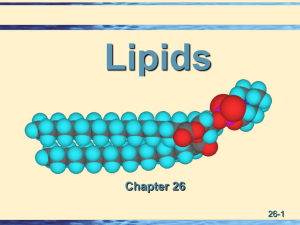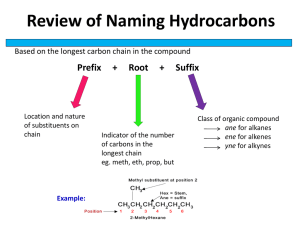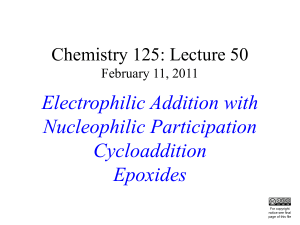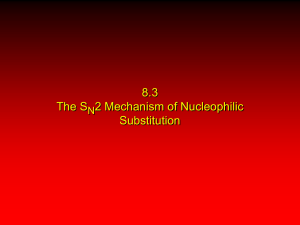06 Lipids
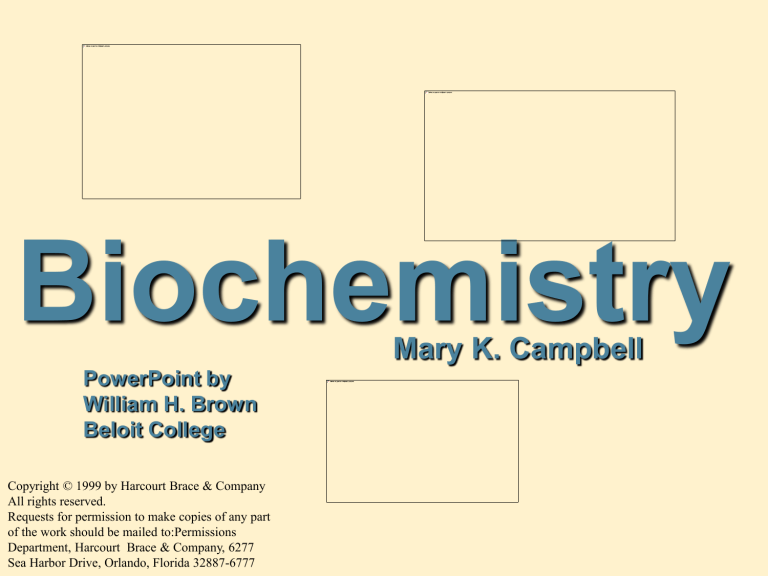
Biochemistry
Mary K. Campbell
PowerPoint by
William H. Brown
Beloit College
Copyright © 1999 by Harcourt Brace & Company
All rights reserved.
Requests for permission to make copies of any part of the work should be mailed to:Permissions
Department, Harcourt Brace & Company, 6277
Sea Harbor Drive, Orlando, Florida 32887-6777
6
Lipids and
Membranes
Copyright (c) 1999 by Harcout Brace & Company
All rights reserved
6-2
•
•
6
Lipids
Lipids: a heterogeneous class of naturally occurring organic compounds classified together on the basis of common solubility properties
• they are insoluble in water, but soluble in aprotic organic solvents, including diethyl ether, chloroform, methylene chloride, and acetone
Lipids include
• triacylglycerols, phosphodiacylglycerols, sphingolipids, glycolipids, lipid-soluble vitamins, and prostaglandins
• cholesterol, steroid hormones, and bile acids
Copyright (c) 1999 by Harcout Brace & Company
All rights reserved
6-3
•
6
Fatty Acids
Fatty acid : a long, unbranched chain carboxylic acid, most commonly of 12 - 20 carbons, derived from hydrolysis of animal fats, vegetable oils, or phosphodiacylglycerols of biological membranes
• In the shorthand notation for fatty acids
• the number of carbons and the number of double bonds in the chain are shown by two numbers, separated by a colon
Copyright (c) 1999 by Harcout Brace & Company
All rights reserved
6-4
6
Fatty Acids
Carbon Atoms/
Double Bonds
12:0
14:0
16:0
18:0
20:0
16:1
18:1
18:2
18:3
20:4
Common
Name lauric acid myristic acid palmitic acid stearic acid arachidic acid palmitoleic acid oleic acid linoleic acid linolenic acid arachidonic acid
Copyright (c) 1999 by Harcout Brace & Company
All rights reserved mp
(°C)
-0.5
16
-5
-11
-49
44
58
63
71
77
6-5
•
6
Fatty Acids
Among the fatty acids most abundant in plants and animals
• nearly all have an even number of carbon atoms, most between 12 and 20, in an unbranched chain
• the three most abundant are palmitic (16:0), stearic acid (18:0), and oleic acid (18:1)
• in most unsaturated fatty acids, the cis isomer predominates; the trans isomer is rare
• unsaturated fatty acids have lower melting points than their saturated counterparts; the greater the degree of unsaturation, the lower the melting point
Copyright (c) 1999 by Harcout Brace & Company
All rights reserved
6-6
6
Triacylglycerols
• Triacylglycerol (triglyceride) : an ester of glycerol with three fatty acids
• natural soaps are prepared by boiling triglycerides
(animal fats or vegetable oils) with NaOH, in a reaction called saponification (Latin, sapo , soap)
O
O
CH
R' CO- CH
2
O- CR
O
CH
2
O- CR' '
A triacylglycerol
(a triglyceride)
Copyright (c) 1999 by Harcout Brace & Company
All rights reserved
Na OH, H
2
O
CH
2
OH
HOCH +
CH
2
OH
1,2,3-Propanetriol
(Glycerol, glycerin)
RCO
2
-
Na
+
R' CO
2
-
Na
+
R' ' CO
2
-
Na
+
Sodium
Soaps
6-7
•
6
Soaps
Soaps form water-insoluble salts when used in water containing Ca(II), Mg(II), and Fe(III) ions
( hard water )
2 CH
3
( CH
2
CO
2
-
Na
+
)
1 4
A sodium soap
(soluble in water as micelles)
+ Ca
2 +
[ CH
3
( CH
2
)
1 4
CO
2
-
]
2
Ca
Calcium salt of a fatty acid
(insoluble in water)
2 +
+ 2 Na
+
Copyright (c) 1999 by Harcout Brace & Company
All rights reserved
6-8
6
Phosphoacylglycerols
• Phosphoacylglycerols (phosphoglycerides) are the second most abundant group of naturally occurring lipids
• found almost exclusively in plant and animal membranes, which typically consist of 40% -50% phosphoacylglycerols and 50% - 60% proteins
• the most abundant phosphoacylglycerols are derived from phosphatidic acid, a molecule in which glycerol is esterified with two molecules of fatty acid and one of phosphoric acid
• the three most abundant fatty acids in phosphatidic acids are palmitic acid (16:0), stearic acid (18:0), and oleic acid (18:1)
Copyright (c) 1999 by Harcout Brace & Company
All rights reserved
6-9
•
6
Phosphoacylglycerols
A phosphatidic acid stearic acid
O
O
O
CH
2
-O- P-O
-
O
-
CH
O CH
2 glycerol
O palmitic acid
• further esterification with a low-molecular weight alcohol gives a phosphoacylglycerol
• among the most common of these low-molecularweight alcohols are
Copyright (c) 1999 by Harcout Brace & Company
All rights reserved
6-10
6
Phosphoacylglycerols
Name and Formula ethanolamine
- OCH
2
CH
2
N H
2 choline
- OCH
2
CH
2
+
N ( CH
3
)
3 serine
- OCH
2
CHCO
2
+
N H
3
-
Copyright (c) 1999 by Harcout Brace & Company
All rights reserved
Name of Phospholipid phosphatidylethanolamine
(cephalin) phosphatidylcholine
(lecithin) phosphatidylserine
6-11
6
Phosphoacylglycerols
inositol phosphatidylinositol
OH
-O OH
HO
HO OH glycerol
OH
- OCH
2
CHCH
2
OH phosphatidylglycerol phosphatidylglycerol
OH O O
- OCH
2
CHCH
2
OPOCHOCR
3
O
-
CH
2
OCR
4
O diphosphophaticylglycerol
(cardiolipin)
Copyright (c) 1999 by Harcout Brace & Company
All rights reserved
6-12
•
6
Phosphoacylglycerols
A lecithin choline stearic acid palmitic acid
O
O
O P OCH
2
-
CH
2
O
CH
2
+
N( CH
3
)
3
O CH
O
O CH
2 glycerol
Copyright (c) 1999 by Harcout Brace & Company
All rights reserved
6-13
6
Waxes
• Esters of long-chain fatty acids and alcohols
• from the Old English word weax = honeycomb
O O
CH
3
( CH
2
)
1 4
CO( CH
2
(honeycombs)
)
3 0
CH
3
A major component of beeswax
O
CH
3
( CH
2
)
3 0
CO( CH
2
)
3 3
A major component of
CH carnauba wax
(the Brazilian wax palm)
3
CH
3
( CH
2
)
1 4
CO( CH
2
)
1 5
A major component of
CH spermacetti wax
(head of the sperm whale)
3
Copyright (c) 1999 by Harcout Brace & Company
All rights reserved
6-14
6
Sphingolipids
( CH
2
)
1 2
CH
3
HO
N H
2
OH
Sphingosine
HO
( CH
2
)
1 2
CH
3
( CH
2
)
1 2
CH
3
O
HO
N HCR
O
O
-
N HCR
OPOCH
2
O
CH
2
N( CH
+
3
A sphingomyelin
)
3
OH
A ceramide
(an N-acylsphingosine)
Copyright (c) 1999 by Harcout Brace & Company
All rights reserved
6-15
•
6
Glycolipids
Glycolipid : a compound in which a carbohydrate is bound to an -OH of the lipid
• many glycolipids are derived from ceramides
( CH
2
)
1 2
CH
3 a unit of
-D-glucopyranose
HO
H
OH
O
N HCR
H
O
HO
HO
O
H a -glucoside bond
H
OH
H
Copyright (c) 1999 by Harcout Brace & Company
All rights reserved
6-16
•
6
Steroids
Steroids : a group of plant and animal lipids that have this tetracyclic ring structure
A B
C D
• The features common to the ring system of most naturally occurring steroids are illustrated on the next screen
Copyright (c) 1999 by Harcout Brace & Company
All rights reserved
6-17
6
Steroids
Copyright (c) 1999 by Harcout Brace & Company
All rights reserved
CH
3
H
CH
3
H
H
H
6-18
6
Cholesterol
HO
H
3
C
H
3
C
H
H H
Copyright (c) 1999 by Harcout Brace & Company
All rights reserved
6-19
•
6
Androgens
Androgens - male sex hormones
• synthesized in the testes
• responsible for the development of male secondary sex characteristics
H
3
C
H
3
C
OH
H
H H
3
C
H
3
C
H
O
H H H H
O HO
Testosterone Androsterone
Copyright (c) 1999 by Harcout Brace & Company
All rights reserved
6-20
•
6
Estrogens
Estrogens - female sex hormones
• synthesized in the ovaries
• responsible for the development of female secondary sex characteristics and control of the menstrual cycle
H
3
C
H
3
C
CH
3
C= O
H
H
H
3
C
OH
H
H H H
O
Progesterone
Copyright (c) 1999 by Harcout Brace & Company
All rights reserved
H
HO
Estradiol
6-21
6
•
Biological Membranes
In aqueous solution, phosphoglycerides spontaneously form into a lipid bilayer, with a back-to-back arrangement of lipid monolayers
(Figure 6.8)
• polar head are in contact with the aqueous environment
• nonpolar tails are buried within the bilayer
• the major force driving the formation of lipid bilayers is hydrophobic interaction
• the arrangement of hydrocarbon tails in the interior can be rigid (if rich in saturated fatty acids) or fluid
(if rich in unsaturated fatty acids)
Copyright (c) 1999 by Harcout Brace & Company
All rights reserved
6-22
6
Biological Membranes
• the presence of cholesterol increases rigidity
• with heat, membranes become more disordered; the transition temperature is higher for more rigid membranes; it is lower for less rigid membranes
Copyright (c) 1999 by Harcout Brace & Company
All rights reserved
6-23
•
•
•
6
Membrane Proteins
Functions : transport substances across membranes, receptor sites, and sites of enzyme catalysis
Peripheral proteins
• bound by electrostatic interactions
• can be removed by raising the ionic strength
Integral proteins
• bound tightly to the interior of the membrane
• removed by treatment with detergents or ultrasonification
• removal generally denatures them
Copyright (c) 1999 by Harcout Brace & Company
All rights reserved
6-24
•
•
6
Fluid Mosaic Model
Fluid : there is lateral motion of components in the membrane;
• proteins, for example, “float” in the membrane and can move along its plane
Mosaic :components in the membrane exist sideby-side as separate entities
• the basic structure is that of a lipid bilayer with proteins, glycolipids, and steroids such as cholesterol embedded in it
• no complexes, as for example, lipid-protein complexes, are formed
Copyright (c) 1999 by Harcout Brace & Company
All rights reserved
6-25
6
Membrane Transport
Passive transport
• driven by a concentration gradient
• simple diffusion : a molecule or ion moves through an opening created by a channel protein
• facilitated diffusion : molecule or ion is carried across a membrane by a carrier protein
• Active transport
• a molecule or ion is moved against a concentration gradient
• see the Na + /K + ion pump (Figs 6.19 - 6.20)
Copyright (c) 1999 by Harcout Brace & Company
All rights reserved
6-26
•
6
Membrane Receptors
Membrane receptors
• generally oligomeric proteins
• binding of a biologically active substance to a receptor initiates an action within the cell
• see the low-density-lipoprotein (LDL) receptor (Fig.
6.21)
• see the Neuromuscular Junction (Figs 6.22-6.24)
Copyright (c) 1999 by Harcout Brace & Company
All rights reserved
6-27
•
6
Lipid-Soluble Vitamins
Vitamins are divided into two broad classes on the basis of their solubility
• those that are lipid-soluble (and hence classified as lipids)
• those that are water-soluble
• The lipid-soluble vitamins include A, D, E, and K
Copyright (c) 1999 by Harcout Brace & Company
All rights reserved
6-28
•
6
Vitamin A
Vitamin A, or retinol, occurs only in the animal world
CH
3
CH
3
CH
3
CH
2
OH
CH
3
CH
3
Retinol (Vitamin A)
• Vitamin A is found in the plant world in the form of a provitamin in a group of pigments called carotenes
(tetraterpenes)
• enzyme-catalyzed cleavage of
-carotene followed by reduction gives two molecules of vitamin A
Copyright (c) 1999 by Harcout Brace & Company
All rights reserved
6-29
6
Vitamin A
CH
3
CH
3
CH
3 site of cleavage H
3
C
H
3
C
CH
CH
3
3
CH
3
Carotene
CH
3
CH
3
CH enzyme-catalyzed cleavage and reduction in the liver
3
CH
3
CH
3
CH
2
OH
CH
3
CH
3
Retinol (Vitamin A)
Copyright (c) 1999 by Harcout Brace & Company
All rights reserved
6-30
•
6
Vitamin A
The best understood role of Vitamin A is its participation in the visual cycle in rod cells
• the active molecule is retinal (vitamin A aldehyde), which forms an imine with an -NH
2 group of the protein opsin to form the visual pigment called rhodopsin
• the primary chemical event of vision in rod cells is absorption of light by rhodopsin followed by isomerization of the 11-cis double bond to the 11-trans configuration
Copyright (c) 1999 by Harcout Brace & Company
All rights reserved
6-31
6
Vitamin A
CH
3
CH
3
CH
3
11-12 cis configuration
CH
3
11
12
CH=N-opsin
H
3
C
CH
3
CH
3
CH
3 light
CH
3
11
12
CH
3
CH=N-opsin
Copyright (c) 1999 by Harcout Brace & Company
All rights reserved
6-32
•
6
Vitamin D
A group of structurally related compounds that play a role in the regulation of calcium and phosphorus metabolism
• the most abundant form in the circulatory system is vitamin D
3
HO
Vitamin D
3
Copyright (c) 1999 by Harcout Brace & Company
All rights reserved
6-33
6
Cholecalciferol
(Vitamin D
3
)
HO
Cholesterol oxidation
HO
HO
Copyright (c) 1999 by Harcout Brace & Company
All rights reserved
7-Dehydrocholesterol
UV
6-34
6
OH
Cholecalciferol
Vitamin D
3
)
1, 25-Dihydroxycholecalciferol
OH
HO
O
2 liver
HO
Copyright (c) 1999 by Harcout Brace & Company
All rights reserved
HO
25-Hydroxycholecalciferol
OH
O
2 kidney
6-35
•
6
Vitamin E
Vitamin E is a group of compounds of similar structure; the most active is a
-tocopherol
OH
H
3
C CH
3 four isoprene units beginning here and ending at the aromatic ring
H
3
C
O
H
3
C
CH
3
CH
3
CH
3
CH
3
Vitamin E ( a -Tocopherol)
• an antioxidant; traps HOO• and ROO• radicals formed as a result of oxidation by O
2 of unsaturated hydrocarbon chains in membrane phospholipids
Copyright (c) 1999 by Harcout Brace & Company
All rights reserved
6-36
•
6
Vitamin K
The name of this vitamin comes from the German word Koagulation, signifying its important role in the blood-clotting process isoprene units
Vitamin K
1
Copyright (c) 1999 by Harcout Brace & Company
All rights reserved
Menadione
(a synthetic vitamin K analog)
6-37
6
H
CH
2
- CH
CO
2
-
Glutamate side chain of prothrombin
CO
2
CO
2
vit. K
CH
2
- CH
CO
2
-
Carboxylated glutamate side chain of prothrombin
Copyright (c) 1999 by Harcout Brace & Company
All rights reserved
O
C O
CH
2
- CH Ca
C O
O
Carboxylated glutamate side chain binding calcium ion
Ca
2 +
6-38
•
6
Prostaglandins
Prostaglandins : a family of compounds that have the 20-carbon skeleton of prostanoic acid
9
8
7
6
5
4
3
2
1
CO
2
H
10
11
12
14 16
13 15 17
Prostanoic acid
18
19
20
Copyright (c) 1999 by Harcout Brace & Company
All rights reserved
6-39
•
6
Prostaglandins
Prostaglandins are not stored in tissues as such, but are synthesized from membrane-bound 20carbon polyunsaturated fatty acids in response to specific physiological triggers
• one such polyunsaturated fatty acid is arachidonic acid
9 8
6 5
CO
2
H
11 12 14 15
Arachidonic acid
Copyright (c) 1999 by Harcout Brace & Company
All rights reserved
6-40
6
Prostaglandins
• among those synthesized from arachidonic acid are
O
CO
2
H
HO
PGE
2 HO
HO
CO
2
H
Copyright (c) 1999 by Harcout Brace & Company
All rights reserved
HO
HO
PGF
2 a
6-41
•
6
Prostaglandins
Research on the involvement of PGs in reproductive physiology has produced several clinically useful derivatives
• 15-Methyl-PGF
2a is used as a therapeutic abortifacient extra methyl group at carbon-15
HO
CO
2
H
15
HO
HO CH
3
Copyright (c) 1999 by Harcout Brace & Company
All rights reserved
15-Methyl-PGF
2 a
6-42
6
Prostaglandins
• the PGE
1 analog, misoprostol, is used for prevention of ulceration associated with the use of aspirin-like nonsteroidal antiinflammatory drugs (NSAIDs)
O
CO
2
H
15 16
HO
HO H
PGE
1
O
Copyright (c) 1999 by Harcout Brace & Company
All rights reserved
HO
CO
2
CH
3
HO CH
3
15
16
Misoprostol
6-43
•
6
Leukotrienes
Leukotrienes: derived from arachidonic acid
• found in white blood cells (leukocytes)
• an important property is constriction of smooth muscles, especially in the lungs
HO H
CO
2
H
L-cysteine
Leukotriene C
(its synthesis and release is triggered by allergic reactions)
H S
CH
2
CH
2
CHCO
2
-
NH
2
Copyright (c) 1999 by Harcout Brace & Company
All rights reserved
6-44
6
Thromboxanes
• derived from arachidonic acid
• contain a four-membered cyclic ether within a sixmembered ring
• induce platelet aggregation and smooth muscle contraction
H
O
CO
H O
OH
Thromboxane A
2
(a potent vasoconstrictor)
Copyright (c) 1999 by Harcout Brace & Company
All rights reserved
2
H
6-45
6
End
Chapter 6
Copyright (c) 1999 by Harcout Brace & Company
All rights reserved
6-46




